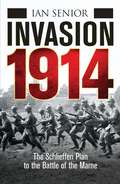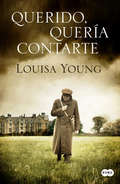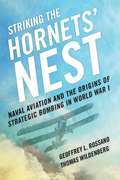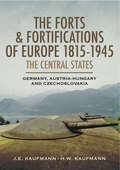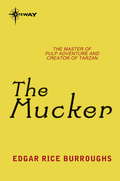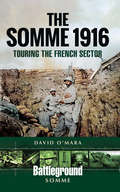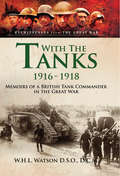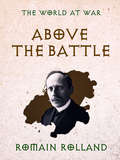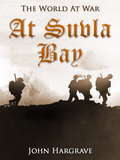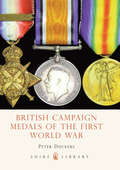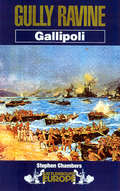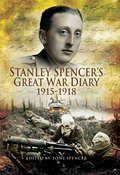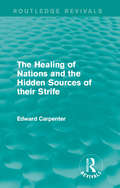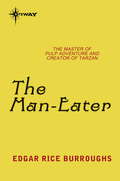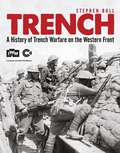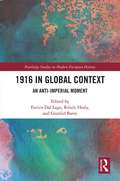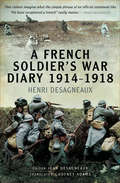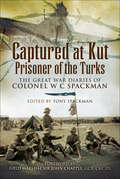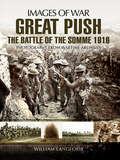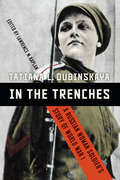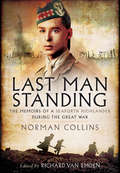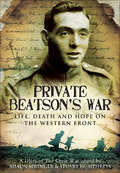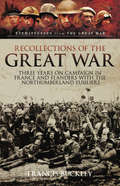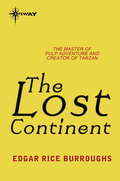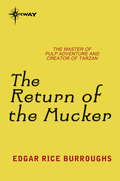- Table View
- List View
Invasion 1914
by Ian SeniorFor a century, accounts of the German invasion of France and the opening year of the First World War have been dominated by histories of British troops and their experience in battle, despite the fact that the British Expeditionary Force comprised just four divisions, while the French and Germans fielded 60 each. Published to coincide with the 100th anniversary of the outbreak of the Great War, Invasion 1914 examines how the German invasion of France and Belgium came agonizingly close to defeating the French armies, capturing Paris and ending the First World War before the end of the year. Ian Senior reveals how the initial German strategy revolved around, and in part depended on, rapid victory over the French, and how the failure to achieve this resulted in the surprisingly fluid battles of the early days of the war deteriorating into the trench-based warfare which was to see the war drag on for another four years of unprecedented slaughter. Weaving together strategic analysis, diary entries, eyewitness accounts and interview transcripts from soldiers on the ground with consummate skill, this narrative is a timely investigation into the dramatic early months of the war, as the fate of Europe hung in the balance.
Querido, quería contarte
by Louisa YoungUna historia de amor épica en los horrores de la Primera Guerra Mundial. En el marco de la Primera Guerra Mundial, en escenarios como Londres, París, el condado de Kent o las trincheras del Frente Occidental, Querido, quería contarte es una conmovedora y brillante novela de amor, clases y sexos en tiempos de guerra, y de cómo esta afecta tanto a quienes se quedan en casa como a los que combaten en el frente. Mientras Peter Locke y Riley Purefoy luchan por su país, su supervivencia y su cordura en las trincheras, sus seres queridos hacen lo que pueden en casa. Julia, hermosa y obsesiva, está casada con Peter, tierno y excéntrico. Solo se le ha enseñado a sentirse valorada por su belleza; ¿de qué le vale ahora en ausencia de su amado esposo? Nadine y Riley, con solo dieciocho años cuando comienza la guerra, con tantos sueños que cumplir y obstáculos que vencer, quieren hacer promesas por encima de todo, pero ¿cómo, si el futuro no está en sus manos? Y en cuanto a Rose, prima de Peter, ¿qué ocurrió con las mujeres de educación tradicional que perdieron la esperanza de casarse cuando los jóvenes de su generación se marcharon a la guerra? A medida que la contienda y sus secuelas convierten el sacrificio y el trauma en parte de la cotidianidad, las vidas de estos personajes se entrecruzan de manera inevitable y cambian para siempre. Querido, quería contarte ofrece un testimonio desgarrador de las secuelas físicas y emocionales de la guerra y del poder del amor incondicional. Comentarios:«Una historia de amor épica, una dura crónica de guerra, un estudio de clases, un reconfortante relato de superación. El sello de "obra maestra clásica" figura en cada una de sus páginas. Una elevada y conmovedora historia de tiempos de guerra en la que el amor triunfa sobre la desesperación».Kirkus «Un mes después de leerlo, en mi mente permanece grabado este libro, la nitidez de sus personajes y sus dilemas aun desentrañándose».Linda Grant, autora de La ropa que vestimos «Es una de esas novelas inolvidables, probablemente para siempre. Me llegó tan al fondo del corazón que quise conservar el propio libro cerca, como si pudiese confortar a los personajes y aferrarme con fuerza a ellos».Jacqueline Winspear, autora de Maisie Dobbs, investigadora privada: el caso de los soldados sin nombre «Un héroe y una heroína irresistibles son el alma. La transformación de sus vidas -en sentido literal y figurado- a raíz de la Primera Guerra Mundial articula una sorprendente novela de suspense y ternura. Me ha cautivado».Margot Livesey, autora de Un mundo de olvido «Tan terrorífica como brillante [...]. Te transporta por uno de los pasajes más oscuros de la experiencia humana y te mantiene agarrado hasta que emerges, profundamente enriquecido, en la otra orilla. Me quedé embelesada desde la primerapágina hasta la última. Con su exquisito y ágil estilo, Young ha recreado un mundo en guerra y le ha dado vida a las silentes caras que yo creía conocer tan bien. Qué equivocada estaba».Anne Fortier, autora de Juliet «Maravillosa».The Times «Convincente y profundamente conmovedora».The Observer «Ha sabido captar el espíritu de la Primera Guerra Mundial de un modo extraordinario [...]. Esta novela es un triunfo».Elizabeth Jane Howard, autora de Igual que el mar «Un relato de amor y pérdida en los horrores de la Primera Guerra Mundial con un hilo narrativo magistral».Psychologies Magazine «Una narradora magistral».The Washington Post
Striking The Hornets' Nest: Naval Aviation And The Origins Of Strategic Bombing In World War I
by Thomas Wildenberg Geoffrey L. RossanoStriking the Hornets’ Nest provides the first extensive analysis of the Northern Bombing Group (NBG), the Navy’s most innovative aviation initiative of World War I and one of the world’s first dedicated strategic bombing programs. Very little has been written about the Navy’s aviation activities in World War I and even less on the NBG. Standard studies of strategic bombing tend to focus on developments in the Royal Air Force or the U. S. Army Air Service. This work concentrates on the origins of strategic bombing in World War I, and the influence this phenomenon had on the Navy’s future use of the airplane. The NBG program faced enormous logistical and personnel challenges. Demands for aircraft, facilities, and personnel were daunting, and shipping shortages added to the seemingly endless delays in implementing the program. Despite the impediments, the Navy (and Marine Corps) triumphed over organizational hurdles and established a series of bases and depots in northern France and southern England in the late summer and early fall of 1918. Ironically, by the time the Navy was ready to commence bombing missions, the German retreat had caused abandonment of the submarine bases the NBG had been created to attack. The men involved in this program were pioneers, overcoming major obstacles only to find they were no longer needed. Though the Navy rapidly abandoned its use of strategic bombing after World War I, their brief experimentation directed the future use of aircraft in other branches of the armed forces. It is no coincidence that Robert Lovett, the young Navy reserve officer who developed much of the NBG program in 1918, spent the entire period of World War II as Assistant Secretary of War for Air where he played a crucial role organizing and equipping the strategic bombing campaign unleashed against Germany and Japan. Rossano and Wildenberg have provided a definitive study of the NBG, a subject that has been overlooked for too long.
The Forts & Fortifications of Europe 1815-1945: Germany, Austria-Hungry and Czechoslovakia
by H. W. Kaufmann J. E. Kaufmann&“Extremely well written and presented and gives you every scrap of information you&’ll ever need on cupolas, embrasures and cloches.&”—War History Online After the Napoleonic Wars, the borders of Central Europe were redrawn and relative peace endured across the region, but the volatile politics of the late nineteenth century generated an atmosphere of fear and distrust, and it gave rise to a new era of fortress building, and this is the subject of this highly illustrated new study. The authors describe how defensive lines and structures on a massive scale were constructed along national frontiers to deter aggression. The Germans, Austro-Hungarians and Czechs all embarked on ambitious building programs. Artillery positions, barbed-wire networks, casemates, concrete bunkers, trench lines, observation posts all sprang up in a vain attempt to keep the peace and to delay the invader. The strategic thinking that gave rise to these defensive schemes is described in detail in this study, as is the planning, design and construction of the lines themselves. Their operational history in wartime, in particular during the Second World War, is a key element of the account. &“A useful introduction for those wishing to develop a knowledge of fortifications and their impact on the conduct of war.&”—Firetrench &“The maps and plans, especially the plans, are numerous and extremely helpful. They show the arrangement of fortifications in a way that simple text would have found impossible. For those with an interest in European land fortifications of the 19th and 20th centuries, this book is an excellent general survey.&”—The Coast Defense Journal
The Mucker
by Edgar Rice BurroughsBilly Byrne was a product of the streets and alleys of Chicago's great West Side. From Halsted to Robey, and from Grand Avenue to Lake Street there was scarce a bartender whom Billy knew not by his first name. And, in proportion to their number which was considerably less, he knew the patrolmen and plain clothes men equally as well, but not so pleasantly. His kindergarten education had commenced in an alley back of a feed-store. Here a gang of older boys and men were wont to congregate at such times as they had naught else to occupy their time, and as the bridewell was the only place in which they ever held a job for more than a day or two, they had considerable time to devote to congregating. They were pickpockets and second-story men, made and in the making, and all were muckers, ready to insult the first woman who passed, or pick a quarrel with any stranger who did not appear too burly. By night they plied their real vocations. By day they sat in the alley behind the feedstore and drank beer from a battered tin pail. The question of labor involved in transporting the pail, empty, to the saloon across the street, and returning it, full, to the alley back of the feed-store was solved by the presence of admiring and envious little boys of the neighborhood who hung, wide-eyed and thrilled, about these heroes of their childish lives. Billy Byrne, at six, was rushing the can for this noble band, and incidentally picking up his knowledge of life and the rudiments of his education. By the time he became an adult, he was another thing entirely. . . .
The Somme 1916: Touring the French Sector (Battleground Somme)
by David O'MaraWith a few notable exceptions, the French efforts on the Somme have been largely missing or minimized in British accounts of the Battle of the Somme. And yet they held this sector of the Front from the outbreak of the war until well into 1915 and, indeed, in parts into 1916. It does not hurt to be reminded that the French army suffered some 200,000 casualties in the 1916 offensive.David OMaras book provides an outline narrative describing the arrival of the war on the Somme and some of the notable and quite fierce actions that took place that autumn and, indeed, into December of 1914. Extensive mine warfare was a feature of 1915 and beyond on the Somme; for example under Redan Ridge and before Dompierre and Fay. The French limited offensive at Serre in June 1915 is reasonably well known, but there was fighting elsewhere for example the Germans launched a short, sharp, limited attack at Frise in January 1916, part of the diversionary action before the Germans launched their ill-fated offensive at Verdun.The book covers the Somme front from Gommecourt, north of the Somme, to Chaulnes, at the southern end of the battle zone of 1916. The reader is taken around key points in various tours. For many British visitors the battlefields south of the Somme will be a revelation; there is much to see, both of cemeteries and memorials, but also substantial traces of the fighting remain on the ground, some of which is accessible to the public.It has always been something of a disgrace that there is so little available, even in French, to educate the public in an accessible written form about the substantial effort made by Frances army on the Somme; this book and subsequent, more detailed volumes to be published in the coming years will go some way to rectify this. British visitors should be fascinated by the story of these forgotten men of France and the largely unknown part of the Somme battlefield.
With the Tanks, 1916–1918: Memoirs of a British Tank Commander in the Great War (Eyewitnesses from The Great War)
by W.H.L. WatsonWilliam Watson was a young Oxford post-graduate at the outbreak of the First World War in 1914. Along with several friends from Oxford he enlisted in the army expecting the war to last six weeks. Watson began his service in the Great War as a British Army motorcycle despatch rider. He saw active service during the key battles of 1914 and early 1915. Watson was then commissioned and became a tank commander and saw active service with the tanks most notably at Cambrai in 1917. This well written and evocative memoir was originally published under the tile 'A Company Of Tanks' it constitutes a wonderful primary source and is an invaluable addition to the library of anyone with an interest in the evolution of the tank as a decisive weapon on the battlefield. Highly detailed, but nonetheless accessible this superb new illustrated edition, edited by Emmy AwardTM winning historian Bob Carruthers is greatly recommended for serious enthusiasts and casual readers alike.
Above the Battle (The World At War)
by Romain RollandAbove the Battle is an anti-world war I treatise by Romain Rolland written in 1916. (Excerpt) "A great nation assailed by war has not only its frontiers to protect: it must also protect its good sense. It must protect itself from the hallucinations, injustices, and follies which the plague lets loose. To each his part: to the armies the protection of the soil of their native land; to the thinkers the defence of its thought. If they subordinate that thought to the passions of their people they may well be useful instruments of passion; but they are in danger of betraying the spirit, which is not the least part of a people's patrimony. One day History will pass judgment on each of the nations at war; she will weigh their measure of errors, lies, and heinous follies. Let us try and make ours light before her!"
At Suvla Bay: Being The Notes And Sketches Of Scenes, Characters And Adventures Of The Dardanelles Campaign - Primary Source Edition (The World At War)
by John HargraveJohn Gordon Hargrave (6 June 1894 - 21 November 1982), (woodcraft name 'White Fox'), was described in his obituary as an 'author, cartoonist, inventor, lexicographer, artist and psychic healer'. As Head Man of the Kibbo Kift, he was a prominent youth leader in Britain during the 1920s and 1930s. He was a Utopian thinker, a believer in both science and magic, and a figure-head for the Social Credit movement in British politics. "At Suvla Bay"; Being the notes and sketches of scenes, characters and adventures of the Dardanelles campaign. (Excerpt from Wikipedia)
British Campaign Medals of the First World War
by Peter DuckersBritain has issued medals rewarding war service since at least the early nineteenth century, and increasingly through the period of its imperial expansion prior to 1914, but examples of many of the early types are now scarce. However, few families escaped some involvement with "the Great War" of 1914-18, and many still treasure the medals awarded to their ancestors for wartime service. Today, with a growing interest in British military history and particularly in family history and genealogy, more and more people want to trace their ancestors' past. This book looks in detail at the origin, types and varieties of the British medals awarded for general war service between 1914 and '18, and gives advice on researching the awards and their recipients.From the Trade Paperback edition.
Gully Ravine: Gallipoli (Battleground Europe)
by Stephen ChambersThis book concentrates on Gully Ravine and its immediate area on the western side of the Helles battlefield. Here trench fighting raged throughout the campaign, culminating in the Battle of Gully Ravine between 28 June and 5 July 1915. This attack was a successful piece of planning and execution, enabling the British to capture five lines of Turkish trenches, seriously threatening the Turkish hold on the southern tip of the peninsula. After this attack the region fell into the deadlock of trench warfare, which brought its horrors as well as its monotony. This beautiful and picturesque area of Gallipoli is seldom visited, and its part in the campaign almost forgotten. The book is well researched and contains a high proportion of original photographs and maps, which have never been published before.
Stanley Spencer's Great War Diary, 1915–1918
by Stanley SpencerStanley Spencer enlisted with the Royal Fusiliers as a private in 1915 and was commissioned in 1917 and thereafter served with the West Yorkshire Regiment until demobilised in 1919. He saw almost continuous active service from 1915 to the end of the War.
The Healing of Nations and the Hidden Sources of their Strife (Routledge Revivals: The Collected Works of Edward Carpenter)
by Edward CarpenterOriginally published in 1915 in the middle of World War I, Carpenter explores the effects that the war was having on society and humankind as a whole from first-hand experience. In particular, papers focus on the differences between Germany and England, the causes of the war and suggestions for restoration and recovery when the war has ended. Carpenter details all of this in a realistic way drawing on matters such as class to put forward his anti-war stance as well as philosophical approaches to coping with tragedy. This title will be of interest to students of history, sociology and politics.
The Man-Eater
by Edgar Rice BurroughsA native woman working in the little cultivated patch just outside the palisade which surrounded the mission was the first to see them. Her scream penetrated to the living room of the little thatched bungalow where the Rev. Sangamon Morton sat before a table. He had heard such screams before. The one thing always uppermost in his mind and the one, great, abiding terror of their lives there in the midst of the savage African jungle was the Wakandas.
Trench
by Stephen Bull'Going up Beek trench on a dark night was no picnic. You started along a long narrow alley winding uphill, your hands feeling the slimy sandbag walls, your feet wary for broken duck boards; now and again a hot, stuff smell, a void space in the wall, and the swish of pumped up water under foot proclaimed the entrance to a mine. ... round corners you dived under narrow tunnels two or three feet high, finally emerging into the comparative open of the front line trench.' Soldier, 1/4th Battalion, Loyal North Lancashire Regiment, 1916In this new book, First World War trench expert Stephen Bull provides a complete picture of trench warfare on the Western Front, from the construction of the trenches and their different types, to the new weaponry and tactics employed in defense and attack. In addition, the book describes the experience of life in the trenches, from length of service, dealing with death and disease, to uniforms and discharge. Alongside his compelling narrative of the campaigns fought in the trenches from 1914 to 1918, annotated trench maps highlight particular features of the trenches, while photographs, documents, and first-hand accounts combine to give a full and richly detailed account of war in the trenches.
1916 in Global Context: An anti-Imperial moment (Routledge Studies in Modern European History)
by Enrico Dal Lago Róisín Healy Gearóid BarryThe year 1916 has recently been identified as "a tipping point for the intensification of protests, riots, uprisings and even revolutions." Many of these constituted a challenge to the international pre-war order of empires, and thus collectively represent a global anti-imperial moment, which was the revolutionary counterpart to the later diplomatic attempt to construct a new world order in the so-called Wilsonian moment. Chief among such events was the Easter Rising in Ireland, an occurrence that took on worldwide significance as a challenge to the established order. This is the first collection of specialist studies that aims at interpreting the global significance of the year 1916 in the decline of empires.
A French Soldier's War Diary 1914–1918
by Henri DesagneauxA classic up-close memoir of fighting in the chaos of World War I. Today, we may have an orderly historical picture of the Great War. But for a soldier like Henri Desagneaux, there was no pattern to be seen from the trenches, where he executed orders ensuring that dozens of men had to die attempting to achieve impossible objectives worked out at a headquarters in the rear. His diary, one of the classic French accounts of the conflict, gives a vivid insight into what it was like to execute those orders, and to live in the trenches with increasingly demoralized, unruly, and mutinous men. In terse, unflinching prose he records their experiences as they confronted the acute dangers of the front line. The appalling conditions in which they fought—and the sheer intensity of the shellfire and the close-quarter combat—have rarely been conveyed with such immediacy.
Captured at Kut, Prisoner of the Turks: The Great War Diaries of Colonel W C Spackman
by Colonel R A SpackmanThis edited diary is Colonel Bill Spackmans extraordinary personal record of his experiences as the Medical Officer of an Indian Infantry battalion during the Mesopotamian Campaign 1914 1916. In particular he describes the harrowing events of the five month siege of Kut and, after the surrender of the 10,000 strong garrison in April 1916, the hardships of the 1,000 mile forced march to Anatolia in Turkey. As a doctor he witnessed at first hand suffering the and deaths of many POWs, both British and Indian.The book goes on the record life in Turkish captivity which was relatively relaxed and fortunately, in sharp contrast to their earlier experiences.Written with humorous understatement and infinite good sense Captured at Kut : Prisoner of the Turks is a gripping read and will appeal strongly not just to Great War enthusiasts but all who enjoy reading of the triumph of men over extreme adversity.
Great Push: The Battle of the Somme, 1916 (Images of War)
by William LangfordIn 1916, Sir Douglas Haig, commanding the BEF, began his great offensive to drive the invaders off the ground they had been occupying for over a year and a half. The Great Push, as the offensive was advertised to the nation, began 1 July 1916. A glossy picture magazine was produced to inform the British public of the progress of the offensive. Over a four month period until the Battle of the Somme faded away in November the magazine appeared with the following advertising blurb:Sir Douglas Haigs Great Push; The Battle of the Somme; A popular, pictorial and authoritative work on one of the Greatest Battles in History, illustrated by about 700 wonderful Official Photographs and Cinematograph Films; By Arrangement With the War Office; beautifully printed on the Best English Art Paper. As is well known, the Great Push turned out to be little more than a nudge, but, for the sake of national morale, the British public had to be encouraged to believe that all was going well; especially in view of the horrific casualties wrecking the lives of families throughout the land.The Great Push, in the form of Images of War, helps capture the propaganda thrust of the times and presents once more the illustrations of those bewildering days.
In the Trenches: A Russian Woman Soldier's Story of World War I
by Tatiana L. DubinskayaTatiana L. Dubinskaya&’s autobiographical novel of life in the Russian army marked the first major work published by a female World War I soldier in the Soviet Union. Often compared to All Quiet on the Western Front, Dubinskaya&’s stark and unsparing story presents a rare look at women in combat and one of the few works of fiction set on the eastern front. Zinaida, a Russian schoolgirl, runs away from home to join the army. Sent to the front, she endures the horrors of trench warfare and the hardships of military life. Undercurrents of revolutionary thinking filter into the ranks as morale begins to crumble. Zinaida must come to grips with the havoc unleashed by the czar&’s overthrow and the new socialist government&’s attempts to impose revolutionary reforms on the army. Destabilization and desertion follow, and her regiment joins the chaotic mass retreat of the Russian army in the summer of 1917. In addition to Dubinskaya&’s original novel, this edition includes selections from her 1936 autobiographical work, Machine Gunner, which she rewrote to satisfy Stalinist censors.
Last Man Standing: The Memiors of a Seaforth Highlander During the Great War
by Norman CollinsA first-hand account of World War I by a nineteen-year-old Englishman who led a platoon into the carnage of the Battle of the Somme. While researching his excellent earlier book: Veterans of World War I, author Richard Van Emden encountered a fascinating personality of that long-ago conflict. After witnessing German naval attacks on British civilians, Norman Collins enlisted in the Seaforth Highlanders of the 51st Highland Division, even though he was under age. Collins fought at the battles of Beaumont Hamel, Arras, and Passchendaele, and was wounded several times. Collins lived to be 100 and had an unusually detailed collection of letters, documents, illustrations and photographs. Richard Van Emden has written a moving biography of a unique personality at war, and his long life after the dramatic events of his youth.&“This is a harrowing tale of battle, loss and the horrors of war.&” —Scotland Magazine&“His collection of letters, photographs and the record of interviews as an old man are a treasure trove of information on Western Front fighting.&” —British Army Review/Soldier Magazine&“Enthralling memoir. These letters form the freshest part of this book, full of detail about kit and food that obsessed soldiers but which do not find a place in the history books.&” —Who Do You Think You Are?&“This is one of the last great first-person memoirs of the Great War. Extraordinary diary, letter collection and photos.&” —Scottish Legion News
Private Beatson's War: Life, Death and Hope on the Western Front
by Edited by Shaun SpringerUntil recently James Beatson was one of the millions of forgotten soldiers of the Great War. But after 90 years his diary has been rediscovered, perfectly preserved, and his story can now be told. It is a moving, intensely personal and beautifully written narrative by an extraordinary young man who witnessed one of the darkest episodes in European history. His experience gives us a telling insight into the thoughts and reactions of a self- educated, patriotic and religious individual confronted by the horrors of warfare on the Western Front. Indeed, after reading the diary of a dead German soldier, Beatson begins to identify more with the thoughts and fears of his enemy than he does with those he loves at home. Reminiscent of some of the greatest of the First World War authors, the diary is also the record of a gifted writer whose potential was tragically curtailed. For, shortly after marrying his childhood sweet heart, he was killed in action at the Battle of the Somme in one of the many failed attacks on High Wood. For this, the first publication of Beatsons diary, Shaun Springer and Stuart Humphreys have edited and illustrated the text and provided an introduction, describing Beatsons family background and the campaign on the Western Front in which he took part. James Beatson was the eldest of nine children. He was raised in Scotland by working-class parents. He was a civil engineer until, as with so many, the declaration of war offered him the chance of adventure. He enlisted in the first days of the war in the Royal Scots and was an eyewitness to the first poison gas attack by the Germans in 1915. Despite the horrors he experienced, Private Beatson never lost his love of humanity nor his faith. He now lies buried, lost somewhere on the Somme when in July 1916 he breathed his last in that infamous battle.
Recollections of the Great War: Three Years on Campaign in France and Flanders with the Northumberland Fusiliers (Eyewitnesses from The Great War)
by Francis BuckleyThis rare primary source account is the story of the hard fighting battalion of the 7th Northumberland Fusiliers, which saw action on the Somme, Passchendaele and in the Battle of Arras. This wonderfully detailed account provides a rare insight into the experiences of the common soldier on the front line during some of the bitterest conflicts of the war.Unembellished and unwavering in his account, Francis Buckley here records not only the events of the battles he fought in, but also provides an emotional tribute to the heroism of the friends he made and lost during his time in the field. As well as his fellow troops of the 7th Northumberland Fusiliers, Buckley also remembers, with great fondness, the bravery of the officers and men of the 149th Infantry Brigade, and of the 50th Division. His recollections here provide a poignant reminder of the true human cost of war in the modern age.
The Lost Continent: The Best Book For Readers (annotated) By Edgar Rice Burroughs
by Edgar Rice BurroughsWar had devastated the entire eastern hemisphere. For two hundred years America had lived in civilized isolation, while Europe had lapsed into legend.Jefferson Turck was the first man who dared recross the 30th meridian, and like Columbus centuries before him, he landed in a New World. For Europe had become the jungle home of savage beasts and her people had banded together in bloodthirsty tribes led by barbarian queens.
The Return of the Mucker
by Edgar Rice BurroughsBilly Byrne squared his broad shoulders and filled his deep lungs with the familiar medium which is known as air in Chicago. He was standing upon the platform of a New York Central train that was pulling into the La Salle Street Station, and though the young man was far from happy something in the nature of content pervaded his being, for he was coming home. After something more than a year of world wandering and strange adventure Billy Byrne was coming back to the great West Side and Grand Avenue. Now there is not much upon either side or down the center of long and tortuous Grand Avenue to arouse enthusiasm, nor was Billy particularly enthusiastic about that more or less squalid thoroughfare. The thing that exalted Billy was the idea that he was coming back to show them. He had left under a cloud and with a reputation for genuine toughness and rowdyism that has seen few parallels even in the ungentle district of his birth and upbringing. A girl had changed him. She was as far removed from Billy's sphere as the stars themselves; but Billy had loved her and learned from her, and in trying to become more as he knew the men of her class were he had sloughed off much of the uncouthness that had always been a part of him, and all of the rowdyism. Billy Byrne was no longer the mucker.
